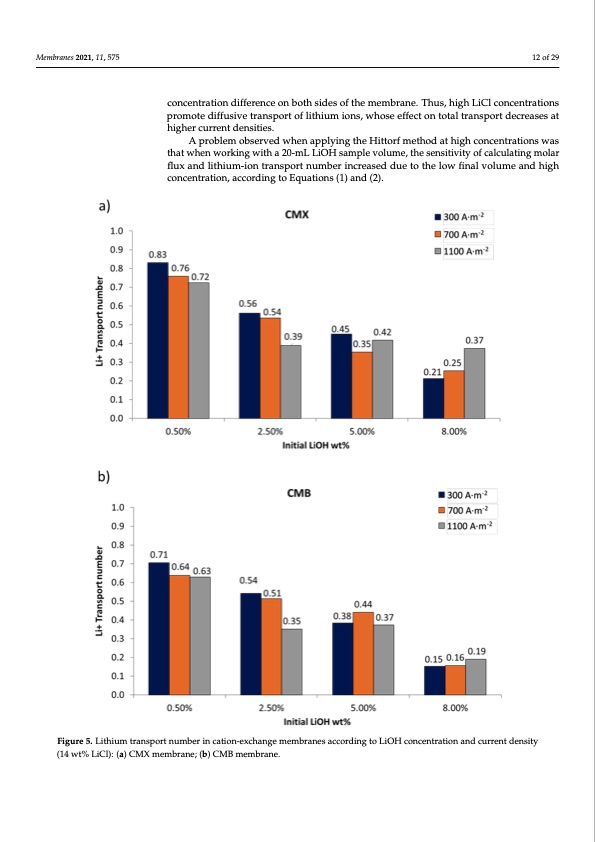
PDF Publication Title:
Text from PDF Page: 012
Membranes 2021, 11, 575 12 of 29 concentration difference on both sides of the membrane. Thus, high LiCl concentrations promote diffusive transport of lithium ions, whose effect on total transport decreases at higher current densities. A problem observed when applying the Hittorf method at high concentrations was Membranes 2021, 11, x FOR PEER REVIEW 12 of 30 that when working with a 20-mL LiOH sample volume, the sensitivity of calculating molar flux and lithium-ion transport number increased due to the low final volume and high concentration, according to Equations (1) and (2). Figure 5. Lithium transport number in cation-exchange membranes according to LiOH concentration and current density Figure 5. Lithium transport number in cation-exchange membranes according to LiOH concentration and current density (14 wt% LiCl): (a) CMX membrane; (b) CMB membrane. (14 wt% LiCl): (a) CMX membrane; (b) CMB membrane. 3.2.1. Influence of Current Density Current density shows influence on lithium transport. As can be seen in Figure 5, the lithium transport number decreases at higher current densities. This can be best observed for initial concentrations of 0.5 wt% and 2.5 wt% LiOH. In the CMX membrane, comparing LiOH concentrations at 0.5 wt% and 2.5 wt%, it was observed that when increasing cur-PDF Image | Bipolar Membrane Electrodialysis for LiOH Production

PDF Search Title:
Bipolar Membrane Electrodialysis for LiOH ProductionOriginal File Name Searched:
membranes-11-00575-v2.pdfDIY PDF Search: Google It | Yahoo | Bing
Product and Development Focus for Infinity Turbine
ORC Waste Heat Turbine and ORC System Build Plans: All turbine plans are $10,000 each. This allows you to build a system and then consider licensing for production after you have completed and tested a unit.Redox Flow Battery Technology: With the advent of the new USA tax credits for producing and selling batteries ($35/kW) we are focussing on a simple flow battery using shipping containers as the modular electrolyte storage units with tax credits up to $140,000 per system. Our main focus is on the salt battery. This battery can be used for both thermal and electrical storage applications. We call it the Cogeneration Battery or Cogen Battery. One project is converting salt (brine) based water conditioners to simultaneously produce power. In addition, there are many opportunities to extract Lithium from brine (salt lakes, groundwater, and producer water).Salt water or brine are huge sources for lithium. Most of the worlds lithium is acquired from a brine source. It's even in seawater in a low concentration. Brine is also a byproduct of huge powerplants, which can now use that as an electrolyte and a huge flow battery (which allows storage at the source).We welcome any business and equipment inquiries, as well as licensing our turbines for manufacturing.| CONTACT TEL: 608-238-6001 Email: greg@infinityturbine.com | RSS | AMP |